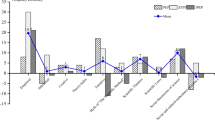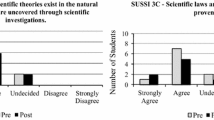Abstract
The purpose of this study was to analyze seven widely used high school biology textbooks in order to assess the nature of science knowledge (NOS) and scientific inquiry (SI) aspects they, explicitly or implicitly, conveyed in the Mendelian genetics sections. Textbook excerpts that directly and/or fully matched our statements about NOS and SI were labeled as explicit and excerpts that partially and/or indirectly matched our statements about NOS and SI were labeled as implicit. There was a running count of each NOS and SI aspect that was identified in the textbooks and the instances were noted to be either implicit or explicit. There were 365 instances of NOS and SI aspects counted in 140 textbook excerpts. Of the 365 instances, 237 (65 %) were NOS aspects and 128 (35 %) were SI aspects. The analysis also revealed far more implicit than explicit instances of NOS and SI. Of the 365 instances, 362 (99 %) were implicit and three (1.0 %) were explicit. The three explicit instances were all SI aspects. In conclusion, the Mendelian genetics sections demonstrated a multitude of opportunities to teach NOS and SI explicitly, although what was included in textbooks was virtually all implicit. This study demonstrates the importance and value for science educators to examine how teachers use instances of NOS and SI in textbooks. Understanding how teachers use instances of NOS and SI would provide information that could be immediately implemented into professional development programs. Lastly, this research would provide textbook developers with compelling information to update the supplemental instruction materials provided to teachers.
Similar content being viewed by others
References
Abd-El-Khalick, F., Bell, R. L., & Lederman, N. G. (1998). The nature of science and instructional practice: Making the unnatural natural. Science Education, 82(4), 417–436.
Achieve, Inc. (2013). Next Generation Science Standards: Achieve, Inc. on behalf of the twenty-six states and partners that collaborated on the NGSS. Retrieved from http://www.nextgenscience.org/.
Allchin, D. (2003). Scientific myth-conceptions. Science Education, 87(3), 329–351.
American Association for the Advancement of Science. (1993). Benchmarks for science literacy: A Project 2061 report. New York: Oxford University.
Bechtel, W. (2006). Discovering cell mechanisms: The creation of modern cell biology. Cambridge: Cambridge University Press.
Biggs, A., Hagins, W. C., Holliday, W. G., Kapicka, C. L., & Lundgren, L. (2009). Glencoe science biology. USA: McGraw-Hill.
Bowler, P. J. (2009). Evolution: The history of an idea. 25th anniversary edition. Berkeley: University of California Press.
Bowler, P. J., & Morus, I. R. (2005). Making modern science: a historical survey. Chicago and New York: The University of Chicago Press.
Central Association for Science and Mathematics Teachers. (1907). A consideration of the principles that should determine the courses in biology in secondary schools. School Science and Mathematics, 7, 241–247.
Churchill, F. B. (1970). Hertwig, Weismann and the meaning of reduction division circa 1890. Isis, 61, 428–457.
Chiappetta, E. L., & Fillman, D. A. (2007). Analysis of five high school biology textbooks used in the United States for inclusion of the nature of science. International Journal of Science Education, 29(15), 1847–1868.
Chiappetta, E. L., Ganesh, T. G., Lee, Y. H., & Phillips, M. C. (2006). Examination of science textbook analysis research conducted on textbooks published over the past 100 years in the United States. Paper presented at the annual meeting of the National Association for Research in Science Teaching, San Francisco, CA.
Chiappetta, E. L., Sthna, G. H., & Fillman, D. A. (1991). A quantitative analysis of high school chemistry textbooks for scientific literacy themes and expository learning aids. Journal of Research in Science Teaching, 20, 787–797.
Dear, P. (2007). The intelligibility of nature: How science makes sense of the world. Chicago and New York: The University of Chicago Press.
Endersby, J. (2007). A guinea pig’s history of biology. Cambridge, Massachusetts and London, England: Harvard University Press.
Gribbin, J. (2003). Science: A history. London: Penguin Books.
Hamoir, G. (1992). The discovery of meiosis by E. Van Beneden, a breakthrough in the morphological phase of heredity. International Journal of Developmental Biology, 36(1), 9–15.
Irzik, G., & Nola, R. (2011). A family resemblance approach to the nature of science for science education. Science & Education, 20(7–8), 591–607.
Jamieson, A., & Radick, G. (2013). Putting Mendel in his place: How curriculum reform in genetics and counterfactual history of science can work together. In K. Kampourakis (Ed.), The philosophy of biology: A companion for educators. Dordrecht: Springer.
Kampourakis, K. (2013). Mendel and the path to genetics: Portraying science as a social process. Science & Education, 2, 293–324.
Kay, L. E. (2000). Who wrote the book of life? A history of the genetic code. Stanford, CA: Stanford University Press.
Keller, E. F. (2000). The century of the gene. Cambridge, MA: Harvard University Press.
Laugksch, R. C. (2000). Scientific literacy: A conceptual overview. Science education, 84(1), 71–94.
Lederman, N. G. (2007). Nature of science: Past, present, and future. In S. Abell & N. Lederman (Eds.), Handbook of research on science education (pp. 831–879). Mahwah, NJ: Erlbaum.
Lederman, N. G., & Lederman, J. S. (2011). The development of scientific literacy: A function of the interactions and distinctions among subject matter, nature of science, scientific inquiry, and knowledge about scientific inquiry. In C. Linder, L. Ostman, D. A. Roberts, P. O. Wickman, G. Erickson, & A. MacKinnon (Eds.), Exploring the landscape of scientific literacy (pp. 127–144). New York: Routledge.
Lederman, N. G., & Lederman, J. S. (2012). Nature of scientific knowledge and scientific inquiry: Building instructional capacity through professional development. In B. J. Fraser, et al. (Eds.), Second international handbook of science education (pp. 335–359). Dordrecht: Springer.
Lederman, N. G., Antink, A., & Bartos, S. (2012). Nature of science, scientific inquiry, and socio-scientific issues arising from genetics: A pathway to developing a scientifically literate citizenry. Science & Education, 22(4), 1–18.
Lederman, N. G., Wade, P. D., & Bell, R. L. (1998). Assessing understanding of the nature of science: A historical perspective. In W. McComas (Ed.), The nature of science and science education: Rationales and strategies (pp. 331–350). Dordrecht, the Netherlands: Kluwer Academic.
Lederman, N. G., Bartos, S., & Lederman, J. S. (2013). The development, use, and interpretation of nature of science assessments. In Michael R. Matthews (Ed.) International Handbook of Research in History, Philosophy and Science Teaching. Springer.
Matthews, M. R. (1994). Science teaching: The role of history and philosophy of science. London: Routledge.
Mayr, E. (1982). The growth of biological thought: Diversity, evolution and inheritance. Cambridge, Massachusetts and London, England: The Belknap Press of Harvard University Press.
Moore, J. A. (1993). Science as a way of knowing: The foundations of modern biology. Cambridge, Massachusetts and London, England: Harvard University Press.
Miller, K. R., & Levine, J. S. (2010). Miller & Levine biology. USA: Pearson Education.
National Research Council. (1996). National science education standards. Washington, DC: National Academic Press.
National Science Teachers. (1982). Science-technology-society: Science education for the 1980s (An NSTA position statement). Washington, DC: Author.
Nowicki, S. (2012). Holt McDougal biology. United States of America: Holt McDougal.
Olby, R. (1994). The path to the double helix: The discovery of DNA, revised edition. Mineola, New York: Dover.
Olby, R. C. (1985). Origins of mendelism (2nd ed.). Chicago and London: The University of Chicago Press.
Orpwood, G. W., & Alam, I. (1984). Science education in Canadian schools. Volume II. Statistical database for Canadian science education background study 52. Hull, Quebec, Canada: Canadian Government Publishing Centre Supply and Services Canada.
Osborne, J., Collins, S., Ratcliffe, M., Millar, R., & Duschl, R. (2003). What “ideas-about-science” should be taught in school science? A Delphi study of the expert community. Journal of Research in Science Teaching, 40(7), 692–720.
Reid, J. B., & Ross, J. J. (2011). Mendel’s genes: Toward a full molecular characterization. Genetics, 189, 3–10.
Reece, J. B., Urry, L. A., Cain, M. L., Wasserman, S. A., Minorsky, P. V., Jackson, R. B., et al. (2012). Campbell biology (9th ed.). USA: Pearson Education.
Resch, B. (Ed.). (2011). BSCS biology: A human approach (4th ed.). USA: Kendall Hunt.
Roberts, D. A. (2007). Scientific literacy/science literacy. In S. Abell & N. Lederman (Eds.), Handbook of research on science education (pp. 729–780). Mahwah, NJ: Erlbaum.
Sapp, J. (2003). Genesis: The evolution of biology. Oxford: Oxford University Press.
Showalter, V. M. (1974). What is united science education? Program objectives and scientific literacy. Prism, II, 2.
Smith, M. U., & Scharmann, L. C. (1999). Defining versus describing the nature of science: A pragmatic analysis for classroom teachers and science educators. Science Education, 83(4), 493–509.
Walpole, B., Merson-Davies, A., & Dann, L. (2011). Biology for the IB diploma coursebook. United Kingdom: Cambridge University Press.
Ward, W., McGonegal, R., Tostas, P., & Damon, A. (2008). Pearson baccalaureate: Higher level biology for the IB diploma. Harlow, GB: Pearson Education Limited.
Weiss, I. R., Banilower, E. R., McMahon, K. C., & Smith, P. S. (2001). Report of the 2000 national survey of science and mathematics education. Chapel Hill, NC: Horizon Research.
Author information
Authors and Affiliations
Corresponding author
Rights and permissions
About this article
Cite this article
Campanile, M.F., Lederman, N.G. & Kampourakis, K. Mendelian Genetics as a Platform for Teaching About Nature of Science and Scientific Inquiry: The Value of Textbooks. Sci & Educ 24, 205–225 (2015). https://doi.org/10.1007/s11191-013-9607-4
Published:
Issue Date:
DOI: https://doi.org/10.1007/s11191-013-9607-4




